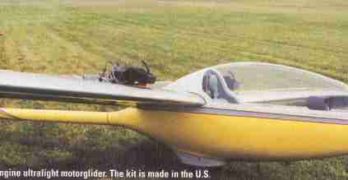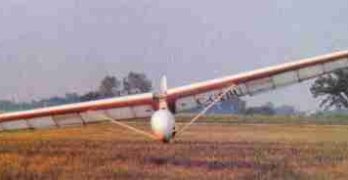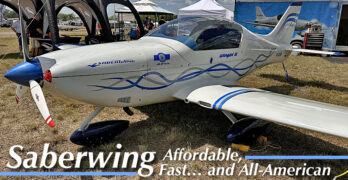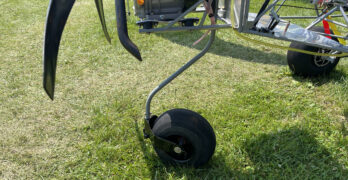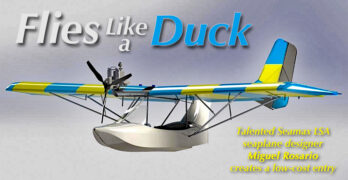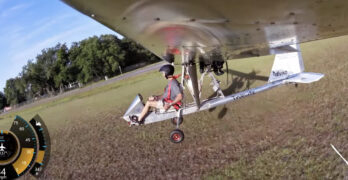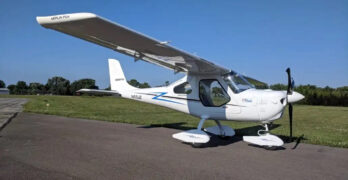Meet the Esprit – a twin-engine ultralight motorglider.
Soaring enthusiasts who want to self-launch their aircraft are limited to simple hang gliders on one end and expensive motorgliders on the other. Performance for these machines ranges 15:1 to 50:1. To get one you’ll spend $5000 or $200,000. What you could not do is spend $20,000 to get medium performance*… until now.
Debuting his machine at AirVenture 2000 airshow, Dobro Hajek brings a modern soaring aircraft to the ultralight community. I believe he will also find significant interest from two other groups: sailplane and hang glider pilots. Each loves dedicated machines without engines but many will also prefer an aircraft that can launch itself.
Welcome, Esprit
With its distinctive compound-tapered wings and winglets and its dual engines with folding props, the sleek Esprit goes a long way past the Aero Dovron that Hajek (pronounced HAY-yek) once imported. The Straton D-8 was an interesting little motorglider with a high wing and struts but at 17:1, this inexpensive machine didn’t have the go power it needed to attract a solid market in the United States.
Search Results for : Part 103
Not finding exactly what you expected? Try our advanced search option.
Select a manufacturer to go straight to all our content about that manufacturer.
Select an aircraft model to go straight to all our content about that model.
Marske Sailplanes
The Marske Monarch continues to offer economical soaring.
Ultralight sailplanes. Are they a new category of aviation, a segment of ultralight aircraft or just little sailplanes? Though ultralights seem to be some of the newer aircraft in general aviation, their true lineage is based on soaring machines.
For example, the first and still most successful ultralights, the Quicksilver series, came from a hang glider design to which a small engine was added back in the 1970s. Trikes, which have continued to grow in worldwide popularity, are based on delta-wing hang gliders to which power and landing gear were added. Therefore, though the term may be relatively new (going back a decade or so), the aircraft has a longer heritage. One shining example of this is Jim Marske’s Monarch.
New Model, Old Design
Marske has been building the Monarch for 20 years and has added his higher performance model, the Pioneer, to his list of designs spanning 40 years.
TEAM Aircraft – Air Bike
TEAM Aircraft – Air Bike
By Dan Johnson, August 1, 1995
“Wow! …what a great little machine,” is how many airshow attendees regarded the unique plane TEAM introduced at Sun ‘n Fun 1994. When the company unloaded the Airbike at the Florida event, it was immediately surrounded with admirers who didn’t leave it alone for the entire week.
The mystique encompassing the Airbike is more than looks. A delightfully simple and light machine, it meets the weight requirements of Part 103 with 30 pounds to spare! An airplane you get on not in, TEAM’s Airbike is aimed at newcomers, or anyone looking for a good time in the air. Derived from their early (never released) EZE-MAX, an all wood design with an equally narrow fuselage, the Airbike represents a departure for TEAM. She’s made up of a welded steel main structure, wood wings, fiberglass upper cowl, aluminum support structure… making the Airbike a genuine “composite.”
Flying an Airbike confirms one thing.
Affordable and Speedy — Saberwing from Azalea plus Spyder Engine
After taking an airshow sabbatical during all of 2024, I was pleased to discover an aircraft at Sun ‘n Fun 2025 that I had never reviewed.
Welcome to Saberwing, an affordable composite kit from Azalea Aviation, which distinguishes itself by also providing an engine to fit the aircraft. Oh, and it’s affordable!
Let’s discover more.
Saberwing and Spyder
Based in Quitman, Georgia, Azalea’s Saberwing was designed for amateur builders seeking a speedy two seater in the LSA description. It has not qualified as a Special LSA but designer and company CEO Bill Clapp said he will consider meeting Mosaic LSA standards when released later this year.
Introduced ten years ago at Sun ’n Fun 2015, this low-wing EAB is “designed to address challenges in the kit aircraft market, emphasizing a simplicity to the kit’s components with fast assembly (500-1,000 hours).” For comparison, RVs often take more than 3,000 hours.
Shark Attack — Review and Video of a Striking Mosaic-Ready Aircraft
Readers who scour the Internet looking for fascinating Light-Sport Aircraft may already know Shark. Conceived by Jaro Dostal in the Czech Republic, this design is the latest from a man who has a long, storied history of aircraft for the light aviation set.
Jaro’s work included the Skyboy from the early days of LSA and later the MD-3 SportRider. Both won approval from many pilots.
All Jaro’s designs have one common easily-seen design characteristic: his shark fin vertical tail. Of course, this one is no different in that respect but it is the first to openly embrace the name. With this speedy aircraft already flying in North America and with more on the way, I couldn’t resist the compelling “Shark Attack” title. Let’s check it out.
Shark.Aero
Shark is built at a factory in the country of Slovakia in a region said to be well known for producing innovative designs.
Badland Ultralight Grows a Nose Wheel
A phenom in the ultralight world, the Badland made news at last year’s AirVenture by rolling out its single cylinder 460cc, 39 hp Thumper engine married to its sturdy chrome molly airframe. This year, Badland unveils two major developments, a nosewheel and carbon fiber ribs.
The Badland nosewheel design is an homage to the Vans RV-8A original nosewheel and is very robust for its size. The nosegear assembly is welded 4130 steel, holding a 4.00×6 nosewheel. The mini tundra tires for the Badland are actually fabricated in house, giving the aircraft its STOL competitor look.
To make up for the added weight, Badland’s founder, Chris Deuel, and his team designed and fabricated light but extremely strong wing ribs using carbon fiber and high-density foam composites. The CF ribs are attached to the aluminum spars using epoxy to provide both a strong bond and isolation from the aluminum and to prevent corrosion.
If It Flies Like a Duck and Floats Like a Duck, Maybe It IS a Duck
Article Updated July 17, 2024 — After this article was posted, Miguel Rosario reported, “Duck is still in tests. Now we will install a 912 ULS 80-horsepower engine, as requested by future customers.” He continued, “Molds are under construction for production, which we hope to start in three months” (approximately October 1, 2024). He finished, “I will keep you updated on all developments regarding Duck.” —DJ
You probably know Seamax. This longtime, performance-oriented LSA seaplane was one of the first to make a splash in the U.S. light aircraft market way back in December, 2007.
Today, regretfully, the Seamax company is going through some very difficult circumstances as noted in this State of the Seaplane Sector report. We don’t know the end of those stories yet.
Nonetheless, Seamax M-22 designer Miguel Rosario remains active. You can’t keep a good man down but apparently you can keep him on the water.
Chip Erwin and the TrueLite Mow the Lawn — And Then Go Flying! (UPDATED AGAIN!)
In our original post, we linked to video of the TrueLite performing taxi tests. Now it’s done better: flying! See the new videos below as Chip Erwin documents the first flights of the TrueLite happening now in Florida.
Those of us looking for pure flying in lightweight form can’t help but be intrigued by the TrueLite ultralight, marketed here by Chip Erwin’s Aeromarine company. “The taxi test went fine. I didn’t have any airspeed reading so I’ll have to see what’s going on there,” Erwin says in the video. While the 36 hp Vittorazzi Cosmos 300 ran a bit hot during the taxi tests, he feels it was because it sat idling for 5 minutes before the test, saying that it cooled down once he got moving.
Here’s a sampling of videos related to the TrueLite.
Affordable Aeromarine Merlin LSA — What’s New?
When thinking of affordable aviation, it’s impossible not to talk about the Aeromarine Merlin LSA. This aircraft is a familiar design for many, as it made its premier in 2016. We’ve talked about it here several times. There have been some exciting changes and updates, a few of which we learned about last month at Sun ’n Fun.
The Aeromarine designed and built 60-hp V-twin liquid cooled four-cycle engine now comes as the standard powerplant. This is a modern engine with electronic ignition, electronic fuel injection and an electric starter. Merlin says this engine will cut fuel consumption at cruise to an average of 2.5 gph, approximately 50% less than the Rotax 582. The Rotax engine is still available as option for those builders that prefer.
The Aeromarine Merlin LSA will also feature as standard a deluxe MGL 8.5-inch EFIS with ADS-B In and Out (FIS-B) avionics panel, elevating your flying experience to the 21st century.
AERO Wrapup: Dave Unwin Concludes His Coverage of AERO Friedrichshafen 2024
With my feet failing fast, and the lederhosen beginning to chafe in a most disagreeable fashion, I viewed the end of AERO 2024 with mixed emotions. My legs said enough is enough, but my head, heart and eyes still wanted more—because what a show it was! From replica rocket-powered fighters to jet packs, LSAs fitted with turbines and paramotors for paraplegics and finally to biplane pusher SSDRs, it was a fabulous event.
The AERO team produced a show that they could justifiably be proud of for the 30th anniversary, and although the weather was unseasonably cool, the action in the halls was as hot as ever, and with more than 270 aircraft in the exhibition halls and in the static display, show-goers were not short of mouth-watering machines to tempt their wallets.
Among the aircraft debuting at the show were the electric DA40 aircraft from Diamond Aircraft in Austria, two electric aircraft and a hydrogen powered one from China and the Integral E from French manufacturer Aura Aero.
- « Previous Page
- 1
- …
- 44
- 45
- 46
- 47
- 48
- …
- 53
- Next Page »


